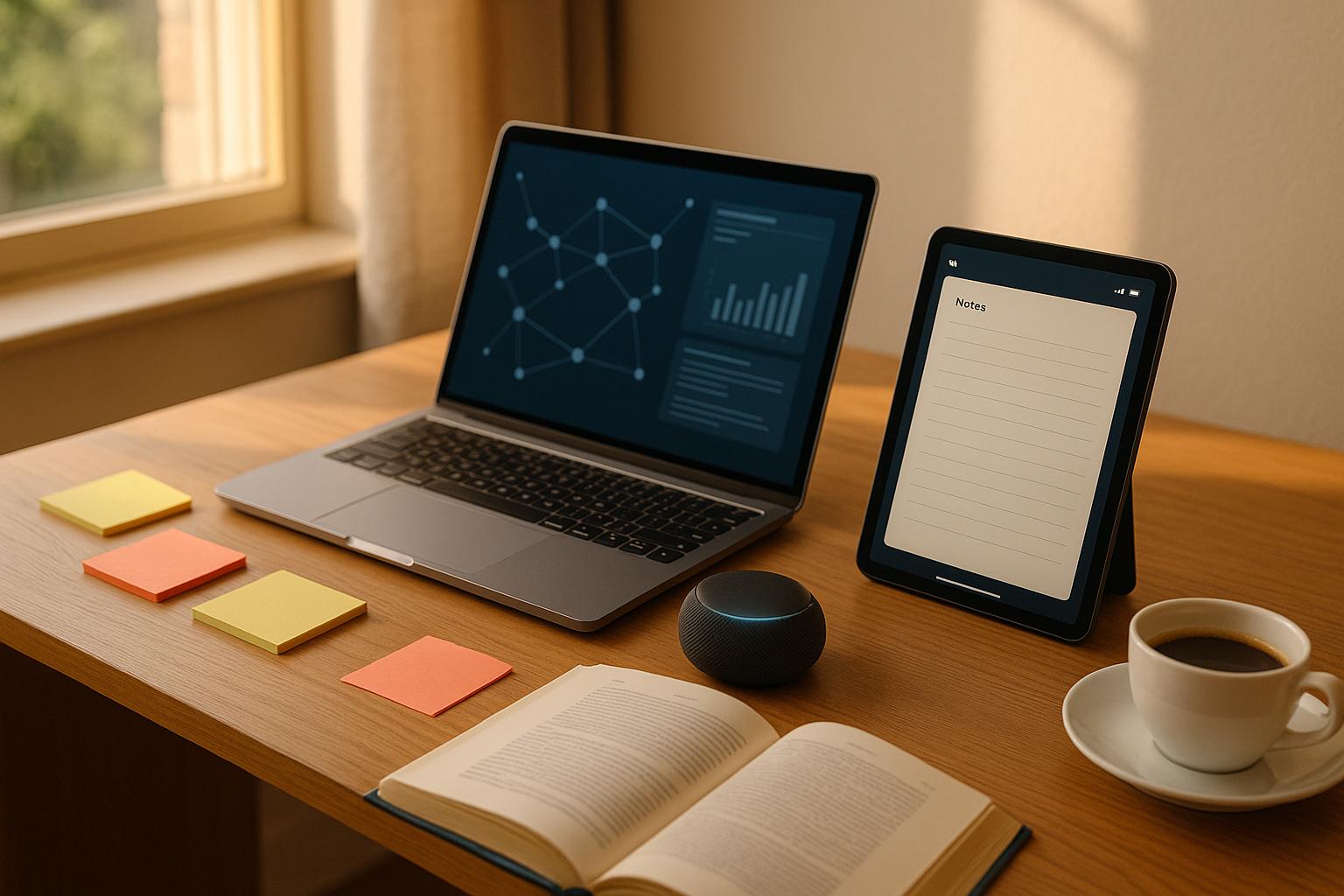AI tools are transforming animation by cutting production time, automating repetitive tasks, and letting animators focus on creativity. Here's a quick breakdown of the key benefits:
- Faster Production: Studios using AI report 30–40% faster project completion.
- Cost Savings: AI reduces manual labor, cutting production costs by 22–35%.
- Creative Freedom: Automates technical tasks like rigging, rendering, and frame interpolation.
- Accessible Tools: Options like Meshy AI, Krikey AI, and Cascadeur make high-quality animation achievable for all studio sizes.
AI is used across animation stages, from pre-production (storyboarding, script analysis) to asset creation (3D models, textures) and quality control (ensuring consistency across frames). Tools like Scriptbook, D-ID, and Ruyi are leading the charge.
Want to integrate AI into your workflow? Start small by automating repetitive tasks, train your team on new tools, and track metrics like production speed and error rates. AI isn’t replacing animators - it’s helping them focus on what they do best: storytelling.
Deliver Faster Rigging and Animation with AI
AI-Enhanced Animation Production Stages
AI tools are transforming animation workflows, cutting production time and effort by more than half.
AI in Pre-Production
AI has made pre-production faster and more efficient by automating tasks like script analysis and storyboarding. For example, modern AI systems can take a script, identify key elements, and automatically create visual storyboards for each scene.
Here are some ways AI is being used during pre-production:
| Task | AI Tool | Benefit |
|---|---|---|
| Script Analysis | Scriptbook | Validates content accuracy |
| Storyboarding | D-ID | Creates visual storyboards |
| Talent Selection | Casting Droid | Matches talent intelligently |
| Production Planning | Yamdu | Optimizes scheduling |
These tools simplify pre-production without compromising creative decision-making. After these steps, AI also plays a major role in asset creation by speeding up the development of models and textures.
AI for Asset Creation
In asset creation, AI has streamlined processes for generating and refining 3D models, textures, and environments. Tools like Meshy AI provide capabilities such as:
- Converting text descriptions into 3D models
- Transforming images into 3D assets
- Generating textures using AI algorithms
- Supporting multiple export formats like OBJ, FBX, USDZ, GLB, STL, and BLEND
"2025 is the year 3D AI takes over! Meshy AI lets you turn a single image into high-quality 3D model. Then, you can choose any angle and bring it to life with an AI video generator. 3D AI is the future of content creation." - el.cine, AI Creator
Once assets are created, AI tools ensure they meet quality and consistency standards.
AI Quality Control Tools
AI-powered quality control tools are boosting production standards by providing real-time feedback and ensuring consistency throughout the animation process. These tools offer:
- Real-time optimization for visual effects (VFX) reviews
- Automated checks for consistency across animation frames
- Verification of backgrounds and environments
- Performance monitoring and improvements
Recent advancements in video model inference speeds have improved by 120%, though creator satisfaction with AI in animation still lags at 31%. CreateAI's Ruyi, launched in December 2024, tackles challenges like maintaining frame consistency and adapting animation styles.
Main AI Animation Tool Categories
AI tools have revolutionized animation by simplifying workflows, sparking creativity, and drastically reducing production time. These tools fall into three main categories: team management, character animation, and scene creation.
Team Management Tools
Managing a team of animators can be challenging, especially when it comes to collaboration and scheduling. AI-powered management systems have stepped in to make these processes more efficient. Companies that rely on AI report a 72% increase in productivity. Here’s how these tools help:
| Feature | Function | Impact |
|---|---|---|
| Task Automation | Handles repetitive tasks | Saves time on manual work |
| Progress Tracking | Monitors work in real-time | Helps meet deadlines |
| Resource Allocation | Optimizes team schedules | Ensures workloads are balanced |
| Communication Hub | Centralizes team feedback | Speeds up revisions |
Character Animation Tools
AI has brought a new level of efficiency and creativity to character animation. Tools like Krikey AI can transform motion capture videos into fully animated characters in just minutes. Some standout features include:
- Facial expression generation for more lifelike characters
- Natural movement synthesis to enhance realism
- Real-time motion capture for instant feedback
- Custom avatar creation tailored to specific projects
"The evolution we've witnessed has transformed these technologies from mere time-savers to genuine creative collaborators for animators." - Michelle Connolly, Founder of Educational Voice
Scene Creation Tools
Building detailed environments is another area where AI shines. Scene creation tools help artists design and refine environments with greater speed and precision. For instance, Cascadeur’s AI-assisted physics tools streamline workflows while ensuring high-quality results. The software supports formats like .FBX, .DAE, and .USD, making it compatible with various production pipelines. These tools are particularly useful for creating visually striking scenes that align with storytelling needs in film, gaming, and virtual reality.
Together, these AI tools integrate smoothly into animation workflows, offering both efficiency and creative possibilities for modern animators.
sbb-itb-212c9ea
Adding AI to Current Animation Workflows
Integrating AI into existing animation workflows can significantly streamline production processes. By carefully incorporating AI tools, teams can save time and effort while maintaining creative quality.
Automating Common Tasks
One of the most practical ways to use AI is by automating repetitive tasks, such as:
- Storyboarding: AI can generate scenes based on scripts or descriptions.
- Character Rigging: Automated bone mapping simplifies the setup for animators.
- Lip Syncing: AI-driven animation matches lip movements to audio tracks.
- VFX Compositing: Background rendering becomes faster and more efficient.
For instance, automating facial capture and lip syncing can reduce what used to take a week down to just a few hours. To make the most of these tools, evaluate your workflow and pinpoint time-intensive tasks that don't require much creative input.
Staff Training for AI Tools
Successful AI integration depends on proper training. CMA CGM's skills accelerator program offers a useful example:
-
Leadership Engagement
Executives participated in upskilling sessions to explore AI's practical applications. -
Department Champions
"We found the AI champion for every department. That became where we went from, 'Let's see how this works,' to an organized approach".
-
Structured Learning Path
Training was broken into clear phases:Training Phase Activities Outcomes Orientation Introduce basic tool functions Understand AI's potential Hands-on Practice Guided exercises and projects Gain practical experience Advanced Usage Develop custom workflows Achieve integration expertise
Once the team is trained, it's essential to monitor how well the tools are performing.
Measuring AI Tool Success
To gauge the impact of AI tools, track these key performance indicators:
- Production Speed: Measure time savings for specific tasks.
- Quality Consistency: Monitor error rates and the need for revisions.
- Team Adoption: Assess how frequently tools are used and how proficient the team becomes.
- Cost Impact: Evaluate ROI, factoring in training and licensing expenses.
"Don't be shy. Don't be afraid. And I guess there's no gain without some level of pain. There are going to be onboarding pains here - there, no doubt about it… but you're going to see quick benefits for sure."
- Stephen Brett, Co-founder of 500 Designs
Set baseline metrics and review progress regularly. Many teams report noticeable efficiency improvements within just 2–3 months.
Finally, platforms like AI Apps can help you find and compare animation tools tailored to your workflow. Advanced filters allow you to search by animation style, budget, and technical needs, making it easier to find the right fit for your team.
Conclusion
Main Points Review
AI tools are transforming animation workflows by boosting efficiency while maintaining creative quality. Studios have reported cutting production costs by 22-35% and completing projects 40% faster. Additionally, a 45% increase in venture funding since 2023 has made high-quality animation more accessible to smaller studios and independent creators.
"Animation used to be the domain of specialists with years of training, but AI has democratised the entire field. What excites me most is how these tools are enabling educators and businesses to communicate complex ideas visually without requiring a massive budget or technical team." – Michelle Connolly, Founder of Educational Voice
Getting Started with AI Tools
If you're ready to integrate AI into your animation workflow, it's essential to start strategically. The key is to enhance your existing processes rather than completely overhauling them. Studios that have done this report higher profit margins and faster production timelines.
"AI doesn't replace artistic vision but amplifies it by handling technical barriers that previously limited creative expression. The real magic happens when human creativity directs these powerful tools." – Michelle Connolly
Take Disney's use of AI in "Frozen II" as an example. Tools like "Swoop" for advanced simulations and "Hyperion" for real-time rendering not only improved visual quality but also streamlined production.
Platforms like AI Apps offer tailored solutions for animation, providing features such as character rigging, motion capture, and scene generation. These focused tools allow teams to incorporate AI in ways that support their unique creative styles.
FAQs
How can small animation studios start using AI tools without disrupting their current workflows?
Small animation studios can make their workflows more efficient by incorporating AI tools that complement their existing processes without causing major disruptions. For instance, tasks like in-betweening and lip-syncing - often time-consuming and repetitive - can be automated with AI, allowing animators to dedicate more time to the creative aspects of their projects.
AI can also prove valuable during pre-production. Tools designed for storyboarding and concept art generation can analyze scripts, produce rough sketches, and even suggest layout ideas. These capabilities help streamline the early stages of production, saving both time and effort. By gradually introducing AI into their operations, studios can boost productivity while maintaining their current workflows.
Which animation tasks can AI automate to give animators more time for creativity?
AI is making waves in animation by taking over repetitive, time-intensive tasks, allowing animators to channel their energy into storytelling and design. For instance, it can automate in-betweening (filling in the frames between keyframes), handle lip-syncing to match audio tracks, manage character rigging, and process motion capture data with ease.
Some AI tools even help generate keyframes, significantly speeding up production while maintaining high-quality results. By simplifying these technical processes, animators can focus on building captivating stories and bringing their creative ideas to life.
How do AI tools like Meshy AI and Krikey AI help maintain quality and consistency in animation projects?
AI tools like Meshy AI and Krikey AI are transforming animation workflows by simplifying complex tasks and refining creative output. Take Meshy AI, for instance - it streamlines asset creation, texturing, and rigging, giving animators more time to focus on crafting compelling stories and stunning visuals. Plus, with features like motion synthesis and automated in-betweening, it delivers fluid, professional-grade animations with ease.
On the other hand, Krikey AI speeds up the animation process by automating character rigging and providing customizable 3D models. This not only cuts down on setup time but also ensures consistency across projects. By incorporating AI into their workflows, animators can achieve polished results faster, with less manual effort.



